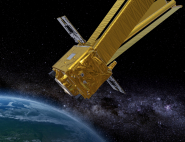Attitude and acceleration control
Like all satellites and spacecraft, Microscope has a function to acquire and maintain its desired angular orientation over time. This angular orientation is called attitude and the function is the Attitude Control System (ACS).
The original feature of Microscope is its ability to continuously control linear accelerations:
- On a normal satellite, linear motion (the orbit) is corrected from time to time by thrusters; but the motion is usually free, subjected to gravitation but also to surface forces (such as aerodynamic forces due to the residual atmosphere, and solar pressure forces due to photon impacts) and other distant (electromagnetic) forces .
- Things are different on Microscope. The satellite’s linear motion is continuously controlled; disturbing forces are compensated by the nitrogen microthrusters to achieve a purely gravitational motion. This control is exerted along the three linear axes, which is why the term 'drag-free satellite' is only part of the picture. Linear control goes together with attitude control, so the system has been named AACS where the first ‘A’ stands for Acceleration. Such accurate three-axis linear control is a world first.
How are drag-free conditions maintained?
Linear measurements from the accelerometers are processed continuously by the satellite’s flight computer to deduce the forces to be imparted by the microthrusters. The commands are sent to the eight microthrusters, which modify their thrust accordingly. A quarter of a second later this process is re-activated and so it continues for months.
The instrument is used as the main sensor in the AACS loop, and a star tracker is also used to estimate the attitude in the long term and correct for any system drift.
In steady state, the propulsion system just balances the non-gravitational forces and the proof masses float almost freely in their cages. It’s as if the satellite was flying around a proof mass used as a guide and correcting its accelerations so that the mass stays at the centre of its cage.
The level of performance required from the AACS is quite extraordinary: the required residual acceleration is 30 pico-g by Hertz root; under such an acceleration, a proof mass set free would take more than two hours to travel just one centimetre!

